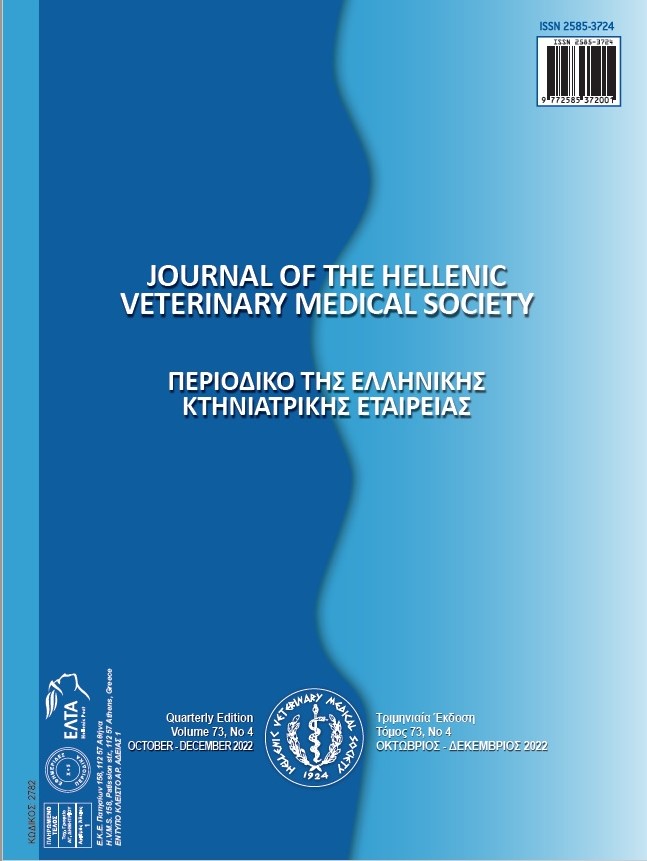NRF2 is a potential biomarker for the evaluation of weaning-related oxidative stress in goat kids
Περίληψη
Weaning stress is crucial threatening factor in animal breeding. The aim of this study was to investigate the effects of weaning to oxidative stress and stress status of goat kids at the molecular levels. In the study, blood samples were collected at the weaning process (7 days before weaning- Pre-W, Day of weaning- Day-W and 7 days after weaning- Post-W) from 24 healthy Damascus goats. Cortisol, MDA (Malondialdehyde), COX-2 (Cyclooxygenase-2), and NRF2 (Nuclear factor erythroid 2-related factor 2) proteins levels were investigated in plasma, while COX-2 and NRF2 genes expression levels were determined from leukocytes. Compared to Pre-W, COX-2 gene was upregulated almost 2-fold in Day-W. On the other hand, NRF2 gene expression levels were tended to upregulation in Day-W, and it was upregulated approximately 2-fold in Post-W. While MDA levels were gradually increased in the weaning process, the levels of COX-2 and NRF2 proteins showed similar changes with gene expression trends. Positive correlations were also found between cortisol and COX-2 and NRF-2 protein levels in plasma. It was thought that significant outputs gained in terms of MDA levels in plasma of kids at the weaning process. For the first time, determination of COX-2 and NRF2 levels both mRNA and protein levels in the weaning process of goat kids were satisfactorily evaluated in this study. Particularly, NRF2 was found to have the potential to be a fundamental biomarker to assess the oxidative status of weaning kids.
Λεπτομέρειες άρθρου
- Πώς να δημιουργήσετε Αναφορές
-
Özkan, H., Kaya, U., Karaaslan, İ, Dalkiran, S., Çamdeviren , B., Yüksel, M., & Yakan, A. (2023). NRF2 is a potential biomarker for the evaluation of weaning-related oxidative stress in goat kids. Περιοδικό της Ελληνικής Κτηνιατρικής Εταιρείας, 73(4), 4925–4932. https://doi.org/10.12681/jhvms.28455
- Τεύχος
- Τόμ. 73 Αρ. 4 (2022)
- Ενότητα
- Research Articles

Αυτή η εργασία είναι αδειοδοτημένη υπό το CC Αναφορά Δημιουργού – Μη Εμπορική Χρήση 4.0.
Οι συγγραφείς των άρθρων που δημοσιεύονται στο περιοδικό διατηρούν τα δικαιώματα πνευματικής ιδιοκτησίας επί των άρθρων τους, δίνοντας στο περιοδικό το δικαίωμα της πρώτης δημοσίευσης.
Άρθρα που δημοσιεύονται στο περιοδικό διατίθενται με άδεια Creative Commons 4.0 Non Commercial και σύμφωνα με την άδεια μπορούν να χρησιμοποιούνται ελεύθερα, με αναφορά στο/στη συγγραφέα και στην πρώτη δημοσίευση για μη κερδοσκοπικούς σκοπούς.
Οι συγγραφείς μπορούν να καταθέσουν το άρθρο σε ιδρυματικό ή άλλο αποθετήριο ή/και να το δημοσιεύσουν σε άλλη έκδοση, με υποχρεωτική την αναφορά πρώτης δημοσίευσης στο J Hellenic Vet Med Soc
Οι συγγραφείς ενθαρρύνονται να καταθέσουν σε αποθετήριο ή να δημοσιεύσουν την εργασία τους στο διαδίκτυο πριν ή κατά τη διαδικασία υποβολής και αξιολόγησής της.




